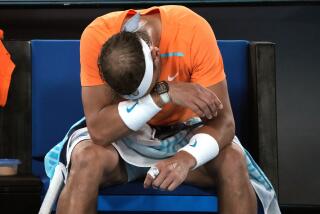After McEnroe’s Big Win Comes a Shot in the Arm : Australian Open: He gets controversial intravenous rehydration treatment.
- Share via
MELBOURNE, Australia — Minutes after his five-set, nearly five-hour, 7-5, 7-6 )7-4), 4-6, 2-6, 8-6) victory over Emilio Sanchez in brutal heat to reach the Australian Open quarterfinals on Sunday, John McEnroe had rehydration fluids dripping into a vein in his arm.
The procedure, which carries serious risks for players, is becoming increasingly popular in pro tennis, and is a source of controversy among doctors and trainers.
There is also concern that the practice may give one player an advantage over another as each tries to recover in time for the next match.
McEnroe, despite playing in 124-degree courtside heat at the start of his match, had none of the medical signs that would necessitate intravenous rehydration with a saline and glucose solution, according to the doctor and trainer who administered the solution.
The IV drip was requested by McEnroe and “his entourage,” including his coach, his brother Patrick and manager, said ATP trainer Rob Hanna.
“He didn’t need to do it, but he did,” Hanna said. “He was not delirious. His vital signs were fine. He had it because of who he is, and his entourage requested it.
“I don’t want the players to get into the habit of doing this. The Americans do it more, but there are risks associated with it. Basically, it’s not really necessary for any top player to be given an IV. Oral rehydration, just drinking water or rehydration fluids, would be just as effective. The players are using this (IV) like a quick fix.”
He said the procedure carries the risk of infection in the arm where the needle is inserted into a vein, and possibly an air embolism that can lead to a stroke if the IV is administered improperly.
The Australian Open doctor who agreed reluctantly to give McEnroe the IV, and ultimately took responsibility for it, also expressed strong reservations about its efficacy, necessity and safety.
“I only believe in using the procedure if it’s absolutely necessary,” said the doctor, who did not want to be quoted by name because of medical rules in Australia. “It’s a matter of judgment. Sometimes it’s not a black-and-white decision. It’s not always easy to decide. But the decision finally is mine, not the patient’s.”
The doctor said the signs that would indicate use of the procedure include hyperthermia, pale, cold skin, an unstable mental state, and abnormal pulse, blood pressure and temperature.
McEnroe, 32, had none of those problems, but may have wanted, or been advised by his entourage, to take the IV as a preventive measure for muscle cramps and as a way to speed his recovery to train for his next match.
“I don’t believe the procedure should be used for preventive purposes for muscle cramps,” the doctor said. “In this case, he’s not playing again for a few days.”
McEnroe declined to discuss his treatment.
“I want to keep it quiet in order to facilitate, hopefully, a victory on Wednesday. Everything’s fine, though. I feel OK now. I feel like I’ll do what’s necessary to be ready, and whatever the advice of the people that I work with, my coach and my brother. Whatever they tell me to do, I’ll listen to. Ultimately, I make the decision, but I just don’t feel like making a big deal out of it. I prefer to just keep it quiet.”
Jimmy Connors had an IV of rehydration solution after at least one of his matches at the U.S. Open last summer, a fatiguing five-setter against Aaron Krickstein in the fourth round.
Dr. Gary Wadler, the internist who administered the IV as one of the U.S. Open doctors, said Connors’ whole body was threatened with muscle cramps because of the loss of electrolytes and minerals.
Wadler justified the use of an IV in Connors’ case, saying it speeded the rehydration fluids into his body.
Connors couldn’t even sit or lie down to take the IV for fear of cramping, Wadler said. Instead, he was hooked up to a bottle drip hanging from a stand on wheels.
More to Read
Go beyond the scoreboard
Get the latest on L.A.'s teams in the daily Sports Report newsletter.
You may occasionally receive promotional content from the Los Angeles Times.










